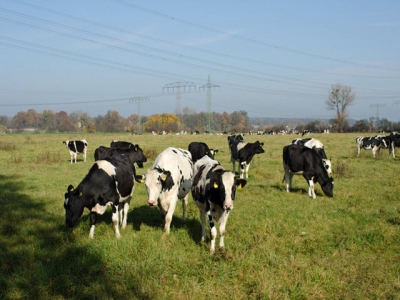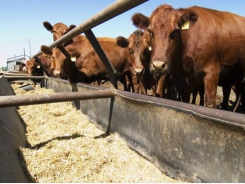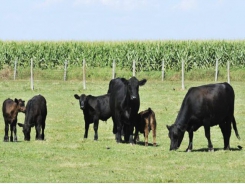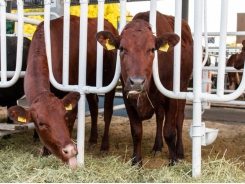Can lipid supplementation decrease enteric methane emission in dairy cows?

A team involving Chilean and UK based researchers tested the effects of including different fat sources in dairy cow diets in the form of unprocessed oilseeds including rapeseed, linseed and cottonseed simultaneously on methane emissions, nitrogen utilization efficiency and milk fat profile.
The results of their study indicate that cottonseed based diet was more efficient in decreasing methane emissions whilst supporting milk production performance than the diets with unprocessed linseed or rapeseed.
However, the team said the cottonseed diet increased excretion of nitrogen in urine, a source of nitrogen pollution.
“Dietary inclusion of unprocessed oilseeds differed in their effects on the response variables studied, and these effects were mostly independent of the degree of fatty acid (FA) unsaturation.”
Key findings of the study
- Unprocessed linseed, rapeseed and cottonseed can be used in dairy cow diets to support milk production.
- Gains in methane mitigation or milk fatty acid profile can be partly offset by nitrogen pollution.
- Methane mitigation strategies need to be evaluated with other environmental, production and consumer health aspects.
Livestock production is a contributor to greenhouse gas (GHG) emissions, representing 14.5% of all human induced emissions, noted the authors. They said, within the GHG emissions linked to the livestock sector, 44% are in the form of enteric methane (Gerber et al., 2013).
In ruminants, most methane is produced by the fermentation of feeds in the rumen, and signifies a loss of between 2 and 12% of the dietary energy ingested (Johnson and Johnson, 1995), added the researchers.
In the last decades, a lot work has been carried out to evaluate dietary strategies that are effective in mitigating ruminant methane emissions.
Dietary lipid supplementation, whether saturated or unsaturated, has been reported as an effective strategy for decreasing methane emission in ruminants (Martin et al., 2010; Hristov et al., 2013), they wrote.
The team said that although there has been research conducted in separate studies on the effects of lipid supplementation on methane production, N use efficiency and milk FA profile, few studies have evaluated these effects simultaneously.
“In addition, there is a scarcity of information on direct comparisons between dairy cow diets containing different lipid sources with differing degrees of unsaturation.
“We hypothesized that the dietary inclusion of unprocessed oilseeds with a greater content of unsaturated fatty acids would have a stronger effect on depressing methane emissions and improving milk composition compared to lipid sources richer in more saturated fatty acids.”
Their objective was to evaluate the effects of dietary inclusion of unprocessed rapeseed, cottonseed and linseed, in comparison with a mixture of prilled fatty acid (FA) from fractionated palm oil on methane emissions, efficiency of N utilization and milk FA profile of dairy cows.
Method
The study was conducted in a dairy cow cohort over a four month period - August to December 2015) in Osorno, Chile. Eight multiparous Holstein Friesian cows were randomly allocated to diets containing different lipid sources.
The various feed formulations included prilled fat consisting of a mixture of fatty acid from fractionated palm oil (PFA; 3.5% of diet DM), Rapeseed (RPS; 6.9% of diet DM), 3) cottonseed (CTS; 18.4% of diet DM) and linseed (LNS; 7.5% of diet DM).
Oilseeds were fed without processing. The researchers said the diets contained varying amounts of corn silage (26 to 27% of diet DM), grass silage (23 to 37% of diet DM), and concentrate (37 to 50% of diet DM), plus the allocated lipid source treatment.
Diets were formulated to provide an ether extract level of 6% of diet DM. Methane emissions were measured using the SF6 technique.
Findings
The RPS diet increased dry matter intake (DMI) compared to the other treatments.
The CTS diet decreased methane production (g/d) and yield (g/kg of DMI) compared to RPS and LNS, and decreased methane intensity (g/kg of energy-corrected milk) compared to RPS, but not LNS or PFA.
The CTS diet increased N excretion in urine. Dietary inclusion of LNS and RPS decreased milk fat content, and the CTS diet tended to increase milk protein, and increased milk lactose contents compared to the PFA diet. However, milk yield and milk components yield were not affected by the diets.
Unprocessed oilseeds improved milk FA profile by increasing mono- and poly-unsaturated FA concentration in milk fat.
Fiber content
It was difficult, they added, to create uniformity in nutrient levels in the various diets:
“Given the range of oilseeds used in the present study, diet formulation posed a challenge for achieving experimental diets with similar levels of energy, protein, fiber and lipids. In particular, cottonseeds had lower EE and higher [neutral detergent fiber] NDF contents then the other oilseeds.
“Consequently, the forage to concentrate ratio of the CTS diet was lower than the other diets, with important differences in non-forage aNDF content. In addition, the PFA and CTS diets resulted in less and more dietary EE, respectively, than what had been formulated.”
The team acknowledged that the methane reduction results achieved with the cottonseed diet might be attributed, at least partially, to the lower intake of digestible fiber in that formulation.
"Also, the smaller particle size of CTS aNDF may have decreased stimulation of chewing activity and thus, lowered rumen pH (Mertens, 2000; Holt et al., 2010), inhibiting methanogens (Janssen, 2010)."
The most important implication of their findings is the need to evaluate methane mitigation strategies in conjunction with other environmental, production and consumer health aspects, they concluded.
Source: Animal Feed Science and Technology
Authors: C. Muñoz, R. Sánchez, A.M.T. Peralta, S. Espíndola, T. Yan, R.Morales, E.M. Ungerfeld
Có thể bạn quan tâm
Phần mềm

Phối trộn thức ăn chăn nuôi

Pha dung dịch thủy canh

Định mức cho tôm ăn

Phối trộn phân bón NPK

Xác định tỷ lệ tôm sống

Chuyển đổi đơn vị phân bón

Xác định công suất sục khí

Chuyển đổi đơn vị tôm

Tính diện tích nhà kính

Tính thể tích ao hồ




 New high-quality reference genome published for water buffalo
New high-quality reference genome published for water buffalo  US: Efficiency, production challenges drive new role for…
US: Efficiency, production challenges drive new role for…